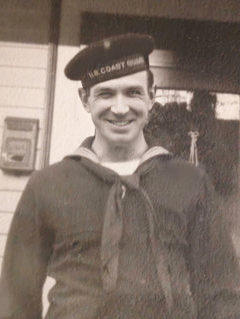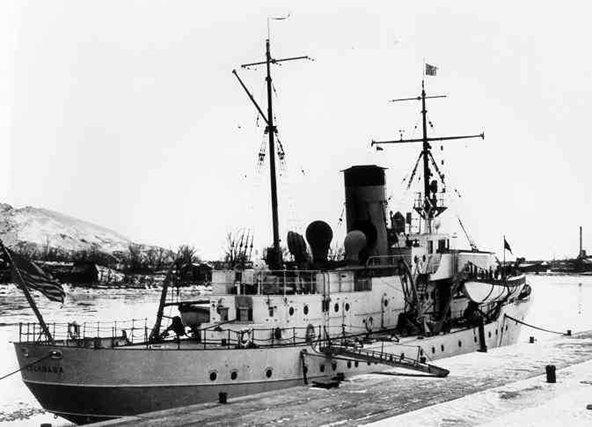
copyright © Wartime Heritage Association 2012-2024
Website hosting courtesy of Register.com - a web.com company
Wartime Heritage
ASSOCIATION
Remembering World War II
Name:
James Freeman Card
Rank:
Fireman Second Class
Service Number:
617373
Service:
USS (USCGC) Escanaba (WPG-77),
United States Coast Guard
Awards:
Purple Heart
Date of Birth:
October 29, 1916
Place of Birth:
Malden, Middlesex County, Massachusetts
Date of Enlistment:
Unknown
Place of Enlistment:
Unknown
Address at Enlistment:
Unknown
Age at Enlistment:
Unknown
Marital Status:
Single at enlistment
Next of Kin:
Carolyn V. Card (Mother)
Date of Death:
June 13, 1943
Age:
26
Cemetery:
East Coast Memorial, Battery Park, New York, New York
Reference:
Tablets of the Missing
James Freeman Card was the son of William Lawson Card (1889-1937)
and Carolyn (Vickery) Card Wickwire (1895–1959). His father was born
in Gaspereau, Kings County, Nova Scotia. His mother was born in
Wolfville, also in Kings Co., NS. William immigrated to the United
States in 1909 travelling from Yarmouth to Boston by ship.
James’ siblings were William Rupert Card (1914–1981), Marion Alice
Card (1920-1989), and Malcolm Lester Card (1925-2005).
All the three Card brothers served. Malcolm also served in the US Navy,
with the Seabees in California, enlisting March 31, 1943, and
discharged December 8, 1945; Seaman 1st Class. He also served as a
police officer. William was a Sergeant and served in the Pacific during
WWII. He enlisted March 7, 1941, until February 3, 1948, enlisting
again February 5, 1948, and serving until September 12, 1962. He retired at the rank of Captain.
James graduated from Malden High School in 1935. He was employed in the Boston Market district before
enlisting.
James served on the USS Escanaba during WWII. The USS or USCGC Escanaba (the US refers to all of its
commissioned ships as USS whether they are Navy or Coast Guard but the Coast Guard also uses the term
USCGC, or United States Coast Guard Cutter) for its vessels, was an “A” type Coast Guard cutter.
On February 3, 1943, Escanaba participated
in the rescue of the survivors of the SS
Dorchester, which had been torpedoed by a
German submarine. The rescue was marked
by the Escanaba's historic first use of rescue
swimmers clad in survival suits to aid
survivors, who were too weakened by shock
or hypothermia in the icy water to pull
themselves up cargo nets or sea ladders to
the safety and warmth of rescuers' ships, or
even to hold on to ropes cast to them from
the rescue vessel. By way of the lines the
rescue swimmers tied around those who
were having trouble helping themselves,
many struggling survivors who--debilitated by the cold--would have otherwise died, were hauled aboard the
Escanaba by crewmen on deck. Even those in the water who appeared to be dead were harnessed by the
retrieval swimmers and pulled aboard – it was found that only 12 of the 50 apparently dead victims thus
brought aboard by the retrieval teams actually turned out to be dead. The rest proved themselves to be
quite alive once given the benefit of warmth, dryness, and medical attention.
On June 10, 1943, the Escanaba began escorting her last convoy, GS-24 from Narsarsuaq, Kujalleq
municipality in southern Greenland to St. John's, Newfoundland, in company with the USS Mojave (WPG-47),
the flagship, the USS Tampa (WPG-48), the USS Storis, and USS Algonquin (WPG-75). The vessels they were
tasked to escort were USAT Fairfax and the tug USS Raritan (WYT-93).
On June 13, 1943, the USS Escanaba apparently hit a mine
(possibly hit by a torpedo) causing her to sink very quickly.
Out of the crew of 105 only 2 survivors were rescued,
Boatswain's Mate 2nd Class Melvin A. Baldwin and Seaman
1st Class Raymond F. O'Malley, Jr. The remains of
Executive Officer Lt. Robert Henry Prause, Jr were also
found.
Fireman 2nd Class James Freeman Card has no known
grave and is therefore remembered on the Tablets of the
Missing at the East Coast Memorial in Battery Park in
Lower Manhattan, New York City, New York. The memorial
commemorates those soldiers, sailors, Marines, coast
guardsmen, merchant mariners and airmen who met their
deaths in the service of their country in the western waters of the Atlantic Ocean during WWII. Its axis is
oriented on the Statue of Liberty.
He is also remembered on a family grave marker at the Wyoming Cemetery in Melrose, Massachusetts, and
on the war memorial at the Bell Rock Park in Malden, Mass.
James Freeman Card









- World War I - Menu
- WWI Stories and Articles
- Photos - Yarmouth Soldiers
- Selection of World War I Songs
- WWI Casualties of Yarmouth, NS
- Those Who Served - Yarmouth, NS
- WWI Casualties Digby Co. NS
- WWI Casualties Shelburne Co. NS
- Merchant Mariners (1915) Yarmouth, NS
- Canadian Forestry Corps - Non Yarmouth Birth/Residence Enlistments
- US Draft Registry - Yarmouth NS Born


- World War II - Menu
- WWII Stories and Articles
- Telegraphist Air Gunners
- WWII Casualties of Nova Scotia
- US Casualties with NS Connection
- Far East/Pacific Casualties with NS Connection
- Merchant Navy Casualties Nova Scotia
- Nova Scotia WWII Casualties Holten Canadian War Cemetery
- D-Day Casualties - Nova Scotia
- CANLOAN Program Casulaties - Nova Scotia
- Battle of the Bulge Casualties - Nova Scotia
- WWII Casualties Yarmouth NS
- Yarmouth Casualties - RCAF RAF Canadian Army WWII
- Yarmouth Co., Marrages WWII
- Casualties Non-Born/Residents with Connection to Yarmouth Co., Nova Scotia.
- WWII Casualties Digby Co., NS
- Non-Nova Scotian WWII Casualties Buried in Nova Scotia
- WWII RCAF Casualties Aged 16-18
- Brothers/Sisters Who Served - World War II













